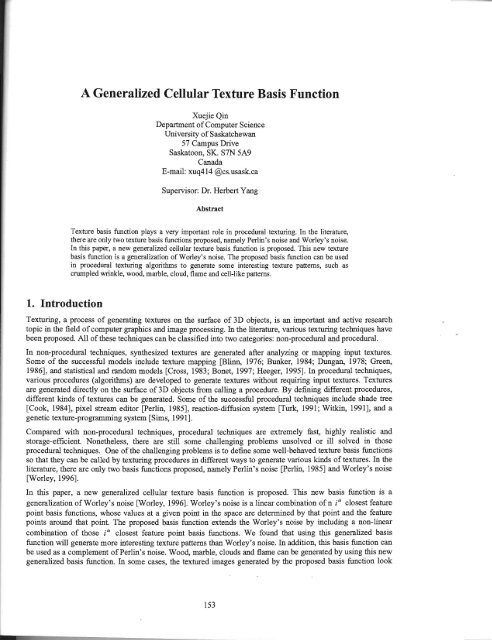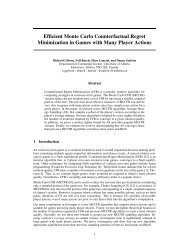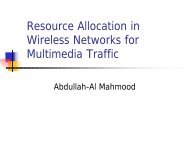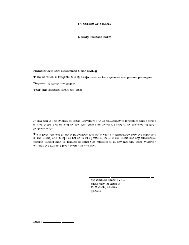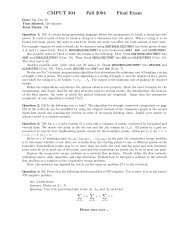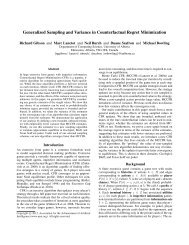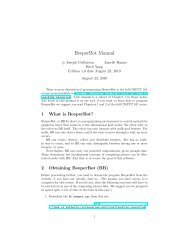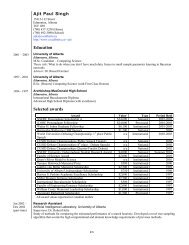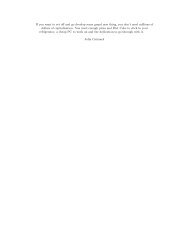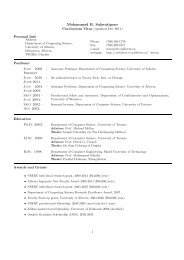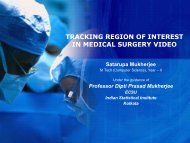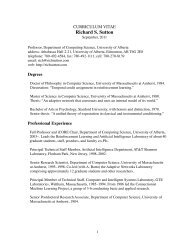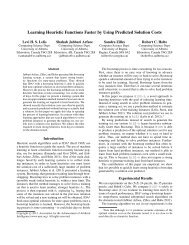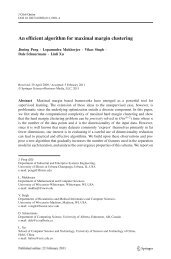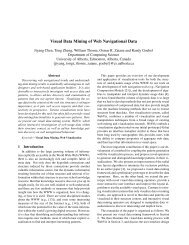Here - Webdocs Cs Ualberta
Here - Webdocs Cs Ualberta
Here - Webdocs Cs Ualberta
- No tags were found...
Create successful ePaper yourself
Turn your PDF publications into a flip-book with our unique Google optimized e-Paper software.
A Generalized Cellular Texture Basis Function<br />
Xuejie Qin <br />
Department of Computer Science <br />
University of Saskatchewan <br />
57 Campus Drive <br />
Saskatoon, SK. S7N 5A9 <br />
Canada <br />
E-mail: xuq4l4 @cs.usaskca <br />
Supervisor: Dr. Herbert Yang <br />
Abstract<br />
Texture basis function plays a very important role in procedural texturing. In the literature,<br />
there are only two texture basis functions proposed, namely Perlin's noise and Worley's noise.<br />
In this paper, a new generalized cellular texture basis function is proposed. This new texture<br />
basis function is a generalization of Worley's noise. The proposed basis function can be used<br />
in procedural texturing algorithms to generate some interesting texture patterns, such as<br />
crumpled wrinkle, wood, marble, cloud, flame and cell-like patterns.<br />
1. Introduction<br />
Texturing, a process of generating textures on the surface of 3D objects, is an important and active research<br />
topic in the field ofcomputer graphics and image processing. In the literature, various texturing techniques have<br />
been proposed. All of these techniques can be classified into two categories: non-procedural and procedural.<br />
In non-procedural techniques, synthesized textures are generated after analyzing or mapping input textures.<br />
Some of the successful models include texture mapping [Blinn, 1976; Bunker, 1984; Dungan, 1978; Green,<br />
1986], and statistical and random models [Cross, 1983; Bonet, 1997; Heeger, 1995]. In procedural techniques,<br />
various procedures (algorithms) are developed to generate textures without requiring input textures. Textures<br />
are generated directly on the surface of 3D objects from calling a procedure. By defining different procedures,<br />
different kinds of textures can be generated. Some of the successful procedural techniques include shade tree<br />
[Cook, 1984], pixel stream editor [Perlin, 1985], reaction-diffusion system [Turk, 1991; Witkin, 1991], and a<br />
genetic texture-programming system [Sims, 1991].<br />
Compared with non-procedural techniques, procedural techniques are extremely fast, highly realistic and<br />
storage-efficient. Nonetheless, there are still some challenging problems unsolved or ill solved in those<br />
procedural techniques. One of the challenging problems is to define some well-behaved texture basis functions<br />
so that they can be called by texturing procedures in different ways to generate various kinds of textures. In the<br />
literature, there are only two basis functions proposed, namely Perlin's noise [Perlin, 1985] and Worley's noise<br />
[Worley, 1996].<br />
In this paper, a new generalized cellular texture basis function is proposed. This new basis function is a<br />
generalization of Worley's noise [Worley, 1996]. Worley's noise is a linear combination ofn i 'h closest feature<br />
point basis functions, whose values at a given point in the space are determined by that point and the feature<br />
points around that point. The proposed basis function extends the Worley's noise by including a non-linear<br />
combination of those i'h closest feature point basis functions. We found that using this generalized basis<br />
function will generate more interesting texture patterns than Worley's noise. In addition, this basis function can<br />
be used as a complement of Perlin's noise. Wood., marble, clouds and flame can be generated by using this new<br />
generalized basis function. In some cases, the textured images generated by the proposed basis function look<br />
153


